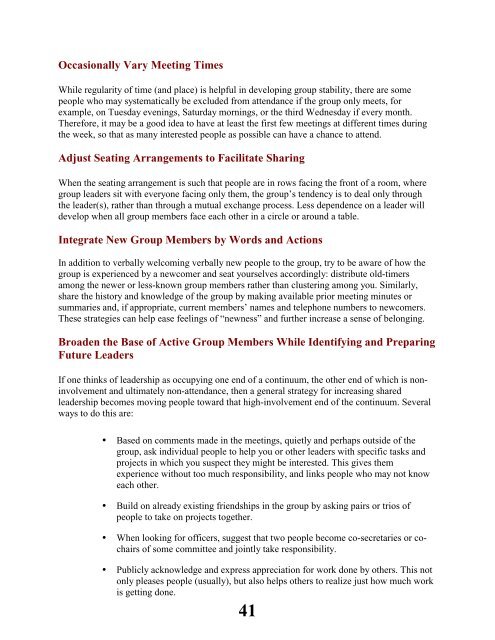Support Group - Michigan Diabetes Outreach Network
Support Group - Michigan Diabetes Outreach Network
Support Group - Michigan Diabetes Outreach Network
Create successful ePaper yourself
Turn your PDF publications into a flip-book with our unique Google optimized e-Paper software.
Occasionally Vary Meeting Times<br />
While regularity of time (and place) is helpful in developing group stability, there are some<br />
people who may systematically be excluded from attendance if the group only meets, for<br />
example, on Tuesday evenings, Saturday mornings, or the third Wednesday if every month.<br />
Therefore, it may be a good idea to have at least the first few meetings at different times during<br />
the week, so that as many interested people as possible can have a chance to attend.<br />
Adjust Seating Arrangements to Facilitate Sharing<br />
When the seating arrangement is such that people are in rows facing the front of a room, where<br />
group leaders sit with everyone facing only them, the group’s tendency is to deal only through<br />
the leader(s), rather than through a mutual exchange process. Less dependence on a leader will<br />
develop when all group members face each other in a circle or around a table.<br />
Integrate New <strong>Group</strong> Members by Words and Actions<br />
In addition to verbally welcoming verbally new people to the group, try to be aware of how the<br />
group is experienced by a newcomer and seat yourselves accordingly: distribute old-timers<br />
among the newer or less-known group members rather than clustering among you. Similarly,<br />
share the history and knowledge of the group by making available prior meeting minutes or<br />
summaries and, if appropriate, current members’ names and telephone numbers to newcomers.<br />
These strategies can help ease feelings of “newness” and further increase a sense of belonging.<br />
Broaden the Base of Active <strong>Group</strong> Members While Identifying and Preparing<br />
Future Leaders<br />
If one thinks of leadership as occupying one end of a continuum, the other end of which is noninvolvement<br />
and ultimately non-attendance, then a general strategy for increasing shared<br />
leadership becomes moving people toward that high-involvement end of the continuum. Several<br />
ways to do this are:<br />
y Based on comments made in the meetings, quietly and perhaps outside of the<br />
group, ask individual people to help you or other leaders with specific tasks and<br />
projects in which you suspect they might be interested. This gives them<br />
experience without too much responsibility, and links people who may not know<br />
each other.<br />
y Build on already existing friendships in the group by asking pairs or trios of<br />
people to take on projects together.<br />
y When looking for officers, suggest that two people become co-secretaries or cochairs<br />
of some committee and jointly take responsibility.<br />
y Publicly acknowledge and express appreciation for work done by others. This not<br />
only pleases people (usually), but also helps others to realize just how much work<br />
is getting done.<br />
41





